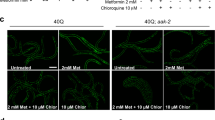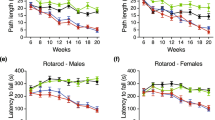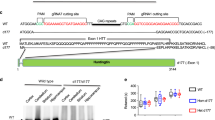Abstract
An expanded polyglutamine domain in huntingtin underlies the pathogenic events in Huntington disease (HD), characterized by chorea, dementia and severe weight loss, culminating in death. Transglutaminase (TGase) may be critical in the pathogenesis, via cross-linking huntingtin. Administration of the TGase competitive inhibitor, cystamine, to transgenic mice expressing exon 1 of huntingtin containing an expanded polyglutamine repeat, altered the course of their HD-like disease. Cystamine given intraperitoneally entered brain where it inhibited TGase activity. When treatment began after the appearance of abnormal movements, cystamine extended survival, reduced associated tremor and abnormal movements and ameliorated weight loss. Treatment did not influence the appearance or frequency of neuronal nuclear inclusions. Unexpectedly, cystamine treatment increased transcription of one of the two genes shown to be neuroprotective for polyglutamine toxicity in Drosophila, dnaj (also known as HDJ1 and Hsp40 in humans and mice, respectively). Inhibition of TGase provides a new treatment strategy for HD and other polyglutamine diseases.
This is a preview of subscription content, access via your institution
Access options
Subscribe to this journal
Receive 12 print issues and online access
$209.00 per year
only $17.42 per issue
Buy this article
- Purchase on Springer Link
- Instant access to full article PDF
Prices may be subject to local taxes which are calculated during checkout



Similar content being viewed by others
References
Green, H. Human genetic diseases due to codon reiteration: relationship to an evolutionary mechanism. Cell 74, 955–956 (1993).
Lorand, L. Neurodegenerative diseases and transglutaminase. Proc. Natl. Acad. Sci. USA 93, 14310–1433 (1996).
Lorand, L. DRPLA aggregation and transglutaminase, revisited. Nature Genet. 20, 231–233 (1998).
Perutz, M.F. Glutamine repeats and neurodegenerative diseases: molecular aspects. Trends Biochem. Sci. 24, 58–63 (1999).
Huntington's Disease Collaborative Research Group. A novel gene containing a trinucleotide repeat that is expanded and unstable on Huntington's disease chromosomes. Cell 72, 971–983 (1993).
Kahlem, P., Green, H. & Djian, P. Transglutaminase action imitates Huntington's Disease: Selective polymerization of huntingtin containing expanded polyglutamine. Mol. Cell 1, 595–601 (1998).
Karpuj, M.V. et al. Transglutaminase aggregates huntingtin into non-amyloidogenic polymers and its enzymatic activity is increased in Huntington's disease brain nuclei. Proc. Natl. Acad. Sci. USA 96, 7388–7393 (1999).
Igarashi, S. et al. Suppression of aggregate formation and apoptosis by transglutaminase inhibitors in cells expressing truncated DRPLA protein with an expanded polyglutamine stretch. Nature Genet. 18, 111–117 (1998).
Lorand, L. Neurodegenerative diseases and transglutaminase. Proc. Natl. Acad. Sci. USA 93, 14310–14313 (1997).
Lesort, M., Chun. W., Johnson, G.V. & Ferrante, R.J. Tissue transglutaminase is increased in Huntington's disease brain. J. Neurochem. 73, 2018–2027 (1999).
Folk, J.E. Transglutaminases. Ann. Rev. Biochem. 49, 517–531 (1980).
Lorand, L. & Conrad S. Transglutaminases. Mol. Cell. Biochem. 58, 25–26 (1984).
Lorand, L. et al. Specificity of guinea pig liver transglutaminase for amine substrates. Biochemistry 18, 1756–1765 (1979).
Mangiarini, L. et al. Exon 1 of the HD gene with an expanded CAG repeat is sufficient to cause a progressive neurological phenotype in transgenic mice. Cell 87, 493–506 (1996).
Ona, V. et al. Inhibition of caspase-1 slows disease progression in a mouse model of Huntington's disease. Nature 399, 263–267 (1999).
Davies, S.W. et al. Formation of neuronal intranuclear inclusions underlies the neurological dysfunction in mice transgenic for the HD mutation. Cell 90, 537–548 (1997).
DiFiglia, M. et al. Aggregation of huntingtin in neuronal intranuclear inclusions and dystrophic neurites in brain. Science 277, 1990–1993 (1997).
Becher, M.W. et al. Intranuclear neuronal inclusions in Huntington's disease and DRPLA: Correlation between the density of inclusions and IT15 CAG triplet repeat length. Neurobiol. Disease 4, 387–397 (1998).
Huang, C.C. et al. Amyloid formation by mutant hutingtin: threshold, progressivity, and recruitment of polyglutamine proteins. Somatic Cell Mol. Genet. 24, 217–233 (1998).
Zainelli, G., Ross, C.A., Troncoso, J.C. & Muma, N.A. Transglutaminase catalyzed cross-links in intranuclear inclusions. Soc. Neurosci. Absracts 26, 1297 (2000).
Ordway J.M. et al. Ectopically expressed CAG repeats cause intranuclear inclusions and a progressive late onset neurological phenotype. Cell 91, 753–763 (1997).
Saudou, P., Finkbeiner, S., Devys, D. & Greenberg, M. Huntingtin acts in the nucleus to induce apoptosis but death does not correlate with the formation of intranuclear inclusions. Cell 95, 55–66 (1998).
Yamamoto, A. Lucas, J.J. & Hen, R. Reversal of neuropathology and motor dysfunction in a conditional model of Huntington's disease. Cell 101, 57–66 (2000).
Orr, H. & Zoghbi, H. Reversing neurodegeneration: a promise unfolds. Cell 101, 1–4, 2000.
Sisodia, S. Nuclear inclusions in glutamine repeat disorders: Are they pernicious, coincidental or beneficial? Cell 95, 1–4 (1998)
Folk, J.E. & Cole, P.W. Transglutaminase: mechanistic features of the active site as determined by kinetic and inhibitor studies. Biochim. Biophys. Acta. 122, 244–264 (1966).
Curtis, C.G. & Lorand, L. Fibrin-stabilizing factor (factor XIII). Methods Enzymol. 45, 177–191 (1976).
Cooper, A.J. et al. Polyglutamine domains are substrates of tissue translutaminase: does transglutaminase play a role in expanded CAG/poly Q neurodegenerative diseases? J. Neurochem. 69, 431–434 (1997).
Bates,G., Mangiarini, L. & Davies, S. Transgenic mice in the study of polyglutamine disease. Brain Pathol. 8, 699–714 (1998).
Sathasivam, K. et al. Formation of polyglutamine inclusions in non-CNS tissue. Hum. Mol. Genet. 8, 813–822 (1999).
Yu, S.P., Yeh, C., Strasser, U., Tian, M. & Choi, D.W. NMDA receptor–mediated K+ efflux and neuronal apoptosis. Science 284, 336–339 (1999).
Isupov, M.N. et al. Substrate binding is required for assembly of the active conformation of the catalytic site in Ntn amidotransferases: evidence from the 1.8 A crystal structure of the glutaminase domain of glucosamine 6-phosphate synthase. Structure 4, 801–810 (1996).
Molberg, O. et al. Tissue transglutaminase selectively modifies gliadin peptides that are recognized by gut-derived T cells in celiac disease. Nature Med. 4, 713–717 (1998).
Newcomb, R., Sun, X., Taylor, L., Curthoys, N. & Giffard, R.G. Increased production of extracellular glutamate by the mitochondrial glutaminase following neuronal death, J. Biol. Chem. 272, 11276–82 (1997).
Luthi-Carter, R. et al. Decreased expression of striatal signaling genes in a mouse model of Huntington's disease. Hum. Mol. Genet. 9, 1259–1271 (2000).
Voehringer, D. et al. Gene microarray identification of redox and mitochondrial elements that control resistance or sensitivity to apoptosis. Proc. Natl Acad Sci USA 97, 2680–2685 (2000).
Kazemi Esfarjani, P., Benzer, S. Genetic suppression of polyglutamine toxicity in Drosophila. Science 287, 1837–1840 (2000).
Scheufler, C. et al. Structure of TPR domain-peptide complexes: critical elements in the assembly of the Hsp70-Hsp90 multichaperone machine. Cell 101, 199–210 (2000).
Kobayashi, Y. et al. Chaperones Hsp70 and Hsp40 suppress aggregate formation and apoptosis in cultured neuronal cells expressing truncated androgen receptor protein with expanded polyglutamine tract. J. Biol. Chem. 275, 8772–8778 (2000).
Cummings, C.J. et al. Chaperone suppression of aggregation and altered subcellular proteasome localization imply protein misfolding in SCA1. Nature Genet. 19, 148–154 (1998).
Chabas, D. et al. The influence of the pro-inflammatory cytokine, osteopontin, on autoimmune demyelinating disease. Science 294, 1731–1735 (2001).
Ferrante, R.J. et al. Neuroprotective effects of creatine in a transgenic mouse model of Huntington's disease. J. Neurosci. 20, 4389–4397 (2000).
Chen, M. et al. Minocycline inhibits caspase-1 and caspase-3 expression and delays mortality in a transgenic mouse model of Huntington disease. Nature Med. 6, 797–801 (2000).
Clarke, G. et al. A one-hit model of cell death in inherited neuronal degenerations. Nature 406, 195–199 (2000).
Jeitner, T.M. et al. N-(γ-L-glutamyl)-l-lysine is increased in cerebrospinal fluid of patients with Huntington's disease. J. Neurochem. 79, 1109–1112 (2001).
Springer, J.E., Azbill, R.D. & Knapp, P.E. Activation of the caspase-3 apoptotic cascade in traumatic spinal cord injury. Nature Med. 5, 943–946 (1999).
Rittling, S.R. & Feng, F. Detection of mouse osteopontin by western blotting. Biochem. Biophys Res Commun 250, 287–292 (1998).
Acknowledgements
We thank J.A. Kotzuk for technical expertise. This work was supported by the Hereditary Disease Foundation (to M.B. and L.S.) and the NIH (Javits Grant to L.S., R0118235).
Author information
Authors and Affiliations
Corresponding author
Ethics declarations
Competing interests
The authors declare no competing financial interests.
Rights and permissions
About this article
Cite this article
Karpuj, M., Becher, M., Springer, J. et al. Prolonged survival and decreased abnormal movements in transgenic model of Huntington disease, with administration of the transglutaminase inhibitor cystamine. Nat Med 8, 143–149 (2002). https://doi.org/10.1038/nm0202-143
Received:
Accepted:
Issue Date:
DOI: https://doi.org/10.1038/nm0202-143
This article is cited by
-
Retinal dysfunction in Huntington’s disease mouse models concurs with local gliosis and microglia activation
Scientific Reports (2024)
-
Single-cell mass cytometry reveals distinct populations of brain myeloid cells in mouse neuroinflammation and neurodegeneration models
Nature Neuroscience (2018)
-
Structural aspects of transglutaminase 2: functional, structural, and regulatory diversity
Apoptosis (2017)
-
Role of tissue transglutaminase-2 (TG2)-mediated aminylation in biological processes
Amino Acids (2017)
-
Transglutaminase 2 has opposing roles in the regulation of cellular functions as well as cell growth and death
Cell Death & Disease (2016)



